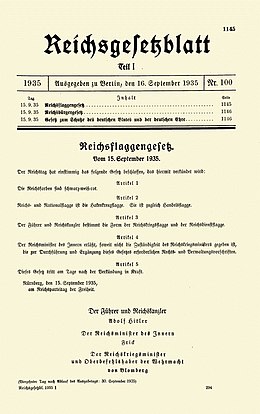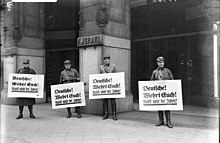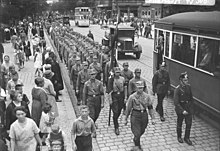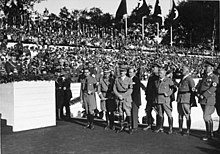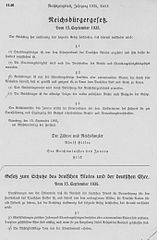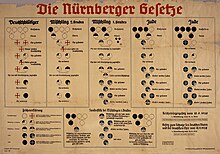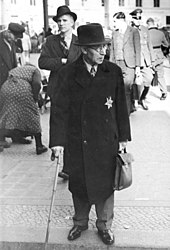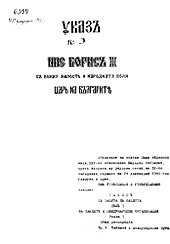Members of the Muscogee (Creek) Nation in Oklahoma around 1877, including some with partial European and African ancestry
Blood quantum laws or Indian blood laws are those enacted in the United States and the former Thirteen colonies to define qualification by ancestry as Native American,
sometimes in relation to tribal membership. These laws were developed
by European Americans and thus did not necessarily reflect how Native
Americans had traditionally identified themselves or members of their in-group,
and thus ignored the Native American practices of absorbing other
peoples by adoption, beginning with other Native Americans, and
extending to children and young adults of European and African ancestry.
Blood quantum laws also ignored tribal cultural continuity after tribes
had absorbed such adoptees and multiracial
children. Tribal enrollments were often incomplete or inaccurate for
multiple reasons; individuals didn't trust the government and so they
refused to enroll, families relocated before censuses were taken, or
individuals were incorrectly identified by white men, whom were the
census takers.
A person's blood quantum (abbreviated as BQ) is defined as the
fraction of their ancestors, out of their total ancestors, who are
documented as full-blood Native Americans. For instance, a person who
has one parent who is a full-blood Native American and one who has no
Native ancestry has a blood quantum of 1/2. Since re-establishing
self-government and asserting sovereignty, some tribes may use blood
quantum as part of their requirements for membership or enrollment,
often in combination with other criteria. For instance, the Omaha Nation requires a blood quantum of 1/4 Native American and descent from a registered ancestor for enrollment.
In 1705 the Colony of Virginia adopted laws that limited civil rights of Native Americans and persons of one-half or more Native American ancestry. The concept of blood quantum was not widely applied by the United States government until the Indian Reorganization Act of 1934. At that time, the government
required persons to have a certain blood quantum to be recognized as
Native American and be eligible for financial and other benefits under
treaties or sales of land.
Since that time, however, Native American nations have
re-established their own governments, asserting sovereignty in setting
their own rules for tribal membership, which vary among them. In some
cases, individuals may qualify as tribal members, but not as American
Indian for the purposes of certain federal benefits, which are still
defined in relation to blood quantum. In the early 21st century, some
tribes, such as the Cherokee and Wampanoag, tightened their membership
rules and excluded persons who had previously been considered members.
Challenges to such policies have been pursued by those excluded. Though
individuals can self-identify as Native American, Native Americans are
the only racial group in the United States that has to have proof of
ancestry to receive government benefits.
Origin of blood quantum law
European Americans passed "Indian Blood law" or blood quantum law to regulate who would be classified as Native American. The Constitution uses the word “Indian” twice but never bothers to define it.
The first such law was passed in 1705 in the Colony of Virginia, to
define Native Americans and to restrict the civil rights of people who
were half or more Native American.
In the 19th and 20th centuries, the US government believed tribal
members had to be defined, for the purposes of federal benefits or
annuities paid under treaties resulting from land cessions.
Many traditionalist Native Americans, known as “irreconcilables”
or “blanket Indians,” were so suspicious of the government that they
refused to enroll at all, making all their descendants unenrollable as
well. Many Native American tribes did not use blood quantum law until the government introduced the Indian Reorganization Act of 1934. Some tribes, such as the Navajo Nation, did not adopt the type of written constitution suggested in that law until the 1950s.
Given intermarriage among tribes, particularly those that are closely
related and have settled near each other, critics object to the federal
requirement that individuals identify as belonging to only one tribe
when defining blood quantum. They believe this reduces an individual's
valid membership in more than one tribe, as well as costing some persons
their qualification as Native American because of having ancestry from
more than one tribe but not 1/4 or more from one tribe. Overall, the
numbers of registered members of many Native American tribes have been
reduced because of tribal laws that define and limit the definition of
acceptable blood quantum.
"The U.S. census decennial enumerations indicate a Native
American population growth for the United States that has been nearly
continuous since 1900 (except for an influenza epidemic in 1918 that caused serious losses), to 1.42 million by 1980 and to over 1.9 million by 1990."
In the 2000 census, there were 2.5 million American Indians. Since
1960, people may self-identify their ancestry on the US Census.
Indian activism and a rising interest in Native American history appear
to have resulted in more individuals identifying as having Native
American ancestry on the census.
For decades, individual tribes had established their own
requirements for membership. In some cases, they have excluded members
who had long been part of the tribe. Common tribal membership
requirements required documented lineal descent from a Native American
member listed on a prior tribal rations-issue roll, or the Dawes Rolls for the 'Five Civilized Tribes' in Oklahoma, or a late 19th-century census;
in some cases they may also require a certain percentage of Native
American ancestry, and demonstrated residence with a tribe or commitment
to the community. Unlike the provisions of the Indian Reorganization
Act, many tribes allow members to claim ancestry in more than one tribe.
For instance, the Little Traverse Bay Bands of Odawa Indians
accept persons of 1/4 North American Indian ancestry, plus documented
descent from an ancestor listed in specific records. In part, this
recognizes that the Odawa people historically had a territory on both
sides of what is now the border between the US and Canada.
Each federally recognized tribe has established its own criteria for membership.
Given the new revenues that many tribes are realizing from gambling
casinos and other economic development, or from settlement of
19th-century land claims, some have established more restrictive rules to limit membership.
In 2007 the Cherokee Nation voted in the majority to exclude as members those Cherokee Freedmen who had no documented ancestors on the Cherokee-by-blood list of the Dawes Rolls.
However, the Cherokee Supreme Court ruled in 2005 that they were
legitimate members of the tribe at that time. After the Civil War, the
US required the Cherokee and other Native American tribes that had
supported the Confederacy to make new treaties. They also required them
to emancipate their slaves, and to give full tribal membership to those
freedmen who wanted to stay in tribal territory. The Cherokee Freedmen
often had intermarried and some had Cherokee ancestry at the time of the
Dawes Rolls, qualifying as Cherokee by blood, but registrars typically
classified them as Freedmen; registration was often inaccurate. Many
individuals also refused to enroll or become documented because they
didn't trust the government.
Similarly, in 2000, the Seminole Nation of Oklahoma
attempted to exclude two bands of Seminole Freedmen from membership to
avoid including them in settlement of land claims in Florida, where
Seminole Freedmen had also owned land taken by the US government.
Since 1942, the Seminole have at times tried to exclude Black Seminoles from the tribe. The freedmen were listed separately on the Dawes Rolls and suffered segregation in Oklahoma.
More recently, the Seminole refused to share with them the revenues of
20th-century US government settlements of land claims. The Center for Constitutional Rights has filed an amicus brief, taking up the legal case of the Black Seminoles and criticizing some officials of the Bureau of Indian Affairs for collaborating in this discrimination by supporting tribal autonomy in lawsuits. By treaty, after the American Civil War, the Seminole were required to emancipate slaves and provide Black Seminoles with all the rights of full-blood Indian members.
American Indian tribes located on reservations tend to have higher blood quantum requirements for membership than those located off reservation....[reference to table] [O]ver 85 percent of tribes requiring more than a one-quarter blood quantum for membership are reservation based, as compared with less than 64 percent of those having no minimum requirement. Tribes on reservations have seemingly been able to maintain exclusive membership by setting higher blood quanta, since the reservation location has generally served to isolate the tribe from non-Indians and intermarriage with them.
Many Native Americans have become used to the idea of "blood quantum".
The blood quantum laws have caused problems in Native American families
whose members were inaccurately recorded as having differing full or
partial descent from particular tribes.
In some cases, family members or entire families have been excluded
from being enrolled as members of their tribe even when they have no
non-Native American ancestors.
At certain times, some state governments classified persons with African American
and Native American admixture solely as African American, largely
because of racial discrimination related to slavery history and the
concept of the one drop rule. This was prevalent in the South after Reconstruction, when white-dominated legislatures imposed legal segregation,
which classified the entire population only as white or colored (Native
Americans, some of whom were of mixed race, were included in the latter
designation). It related to the racial caste system of slavery before
the American Civil War. Until 1870 there was no separate classification on the census for Indian.
The Lumbee, a group that appeared to organize from a variety of free people of color on the North Carolina frontier in the 19th century, achieved state recognition as Croatan Indian in 1885 after Reconstruction. This separate status allowed them to establish a school system for their children distinct from that for freedmen's children.
The question of identity is complex. Researcher Paul Heinegg and Dr. Virginia DeMarce
found that ancestors of 80 percent of free people of color (including
individuals on the census later claimed as Lumbee ancestors) in the 1790
and 1810 censuses on the North Carolina frontier were descended from
families of white women and African
men, and were free in colonial Virginia because of the mother's status.
Many mixed-race people in frontier areas identified as Indian, Portuguese or Arab to escape racial strictures.
In 1952 the Croatan Indians voted to adopt the name of Lumbee. (They were settled near the Lumber River, also called the Lumbee.) They achieved limited federal recognition in 1956 as an ethnic
Indian nation by a special act of the US Congress, and accepted at the
time that it was without benefits. Since then, they have tried to appeal
to Congress for legislation to gain full federal recognition. Their
effort has been opposed by several federally recognized tribes.
In other cases, because mixed-race children were often raised in
the mother's Native American culture, U.S. society considered them
Native American, despite European ancestry. (As the trappers, traders
and soldiers on the frontiers were mostly men, for some time most
European-Native American unions were between European men and Native
women.)
In 1924 Virginia passed the Racial Integrity Act,
which required that every individual be classified as either white or
black. (Some other states adopted similar laws.) In application, the law
was enforced to the standard of the "one drop rule":
individuals with any known African ancestry were classified as black.
As a result, in the censuses of the 1930s and the 1940s, particularly in
the South's segregated society, many people of African American and
Native American heritage who were either biracial or multiracial were
largely classified as black, even though they identified culturally as
Native American.
The result negatively affected many individuals with mixed African
American and Native American heritage. Because there are few
reservations in the South, such individuals had to provide evidence of
ancestry to enroll in a tribe. The changes in historic records erased
their documentation of continuity of identity as Indian.
During the early years of slavery, some Native Americans and Africans
intermarried because they were enslaved at the same time and shared a
common experience of enslavement. Others made unions before slavery
became institutionalized, as they worked together.
Today, the proposed regulations for children adopted into Native
families are that they may not be federally recognized members unless
they have a biological parent who is enrolled in a tribe. Such cases of adoption are probably less frequent than in the past. Historically, especially recorded during the colonial years and the 19th century in the American West,
many tribes adopted young captives taken in war or raids to replace
members who had died. Whether European or of another Native American
tribe, the captives generally were fully assimilated into the tribal
culture and were considered full members of the tribe. Generally, they
remained with the tribe, marrying other members and rearing their
children within the cultural tradition.
In some cases, census rolls for tribes such as the Cherokee
were incomplete due to intermarriage, immigration, treaties, or because
the members were not living within the boundaries of the nation, and
thus would not be recorded on the census. However, as noted above many people have identified as Native American on the US Census but are not eligible for tribal enrollment.
Some critics argue that blood quantum laws helped create racism
among tribal members. The historian Tony Seybert contends that was why
some members of the so-called Five Civilized tribes
were slaveholders. The majority of slave owners were of mixed-European
ancestry. Some believed they were of higher status than full-blood
Indians and people of African ancestry.
Other historians contend that the Cherokee and other tribes held slaves
because it was in their economic interest and part of the general
southeastern culture. Cherokee and other tribes had also traditionally
taken captives in warfare to use as slaves, though their institution
differed from what developed in the southern colonies.
Issues with DNA ancestry testing
No federally recognized tribe enrolls members solely based on DNA testing, as it generally cannot distinguish among tribes.
Some tribes may require DNA testing only to document that a child is
related to particular parents. Many researchers have published articles
that caution that genetic ancestry DNA testing has limitations and
should not be depended on by individuals to answer all their questions
about heritage.
Many African Americans may have some Native American ancestry. But, in the PBS series led by historian Henry Louis Gates, Jr., called African American Lives, geneticists said DNA evidence shows that African-Native American admixture may not be that common. Gates summarized the data:
Only 5 percent of African Americans have at least one-eighth Native American ancestry (equivalent to one great-grandparent). On the other hand, nearly 78 percent of African Americans have at least one-eighth European ancestry (the equivalent to a great-grandparent), and nearly 20 percent have at least one-quarter European ancestry (the equivalent to a grandparent.)
Some
authors, assert a much higher percentage of Native American ancestry
because many people of African American descent knew about their Native
American relatives, but felt that to acknowledge it would be to deny
their African heritage. However, now many acknowledge both their African
and Native American heritage.
Some critics thought the PBS series African American Lives did not sufficiently explain such limitations of DNA testing for assessment of heritage. In terms of persons searching for ethnic ancestry, they need to understand that Y-chromosome and mtDNA
(mitochondrial DNA) testing looks only at "direct" line male and female
ancestors, and thus can fail to pick up many other ancestors' heritage.
Newer DNA tests can survey all the DNA that can be inherited from
either parent of an individual, but at a cost of precision. DNA tests
that survey the full DNA strand focus on "single nucleotide
polymorphisms" or SNPs, but SNPs might be found in Africans, Asians, and
people from every other part of the world. Full survey DNA testing
cannot accurately determine an individual's full ancestry.
Though DNA testing for ancestry is limited more recent genetic testing
research of 2015, have found that varied ancestries show different
tendencies by region and sex of ancestors. These studies found that on
average, African Americans have 73.2-82.1% West African, 16.7%-29% European, and 0.8–2% Native American genetic ancestry, with large variation between individuals.
Implementation
Many
Native American tribes continue to employ blood quantum in current
tribal laws to determine who is eligible for membership or citizenship
in the tribe or Native American nation. These often require a minimum
degree of blood relationship and often an ancestor listed in a specific
tribal census from the late 19th century or early 20th century. The Eastern Band of Cherokee Indians of North Carolina,
for example, require an ancestor listed in the 1924 Baker census and a
minimum of 1/16 Cherokee blood inherited from their ancestor(s) on that
roll. Meanwhile, the Cherokee Nation requires applicants to descend from an ancestor in the 1906 Dawes roll (direct lineal ancestry), but does not impose minimum blood quantum requirement. The United Keetoowah Band requires a minimum 1/4 blood quantum.
The Ute require a 5/8 blood quantum, the highest requirement of any American tribe. The Miccosukee of Florida, the Mississippi Choctaw, and the St. Croix Chippewa of Wisconsin all require one-half "tribal blood quantum", also a high percentage.
At the other end of the scale, some tribes, such as the Kaw Nation, have no blood quantum requirement.
Many tribes, such as Alabama-Quassarte Tribal Town and the Wyandotte Nation, require an unspecified amount of Indian ancestry (known as "lineal descendancy")
documented by descent from a recognized member. Others require a
specified degree of Indian ancestry but an unspecified share of ancestry
from the ancestral tribe or tribes from which the contemporary tribal
entity is derived, such as the Grand Traverse Band of Ottawa and Chippewa Indians and the Poarch Band of Creek Indians.
Many tribes today are confederations of different ethnic groups joined
into a single political entity making the determination of blood quantum
challenging.
Other tribes require a minimum blood degree only for tribal members born "off" (outside) the nominal reservation. This is a concept comparable to the legal principles of Jus soli and Jus sanguinis in the nationality laws of modern sovereign states.
Tribes requiring 1/2 degree blood quantum for membership
(equivalent to one parent)
- Chippewa Cree, Montana
- Kialegee Tribal Town
- Miccosukee Tribe of Indians of Florida
- Mississippi Band of Choctaw Indians, Mississippi
- St. Croix Chippewa Indians of Wisconsin
- Pueblo of Isleta, New Mexico
- White Mountain Apache Tribe, Arizona
- Yomba Shoshone Tribe, Nevada
Tribes requiring 1/4 degree blood quantum for membership
(equivalent to one grandparent)
- Absentee-Shawnee Tribe of Indians, Oklahoma
- Ak-Chin Indian Community, Arizona
- Blackfeet Tribe of the Blackfeet Indian Reservation of Montana
- Cheyenne and Arapaho Tribes, Oklahoma
- Confederated Tribes and Bands of the Yakama Nation, Washington
- Confederated Tribes of the Chehalis Reservation, Washington
- Ho-Chunk Nation of Wisconsin Wisconsin
- Hopi Tribe of Arizona
- Kickapoo Traditional Tribe of Texas
- Kickapoo Tribe of Oklahoma, Oklahoma
- Kiowa Tribe of Oklahoma, Oklahoma
- Fort McDowell Yavapai Nation, Arizona
- Fort Peck Assiniboine and Sioux Tribes, Montana
- Lac du Flambeau Ojibwe Nation, Wisconsin
- Mohawk Tribe, New York and Ontario/Quebec, Canada
- Navajo Nation, Arizona, Utah and New Mexico
- Oneida Tribe of Indians, Wisconsin
- Pascua Yaqui Tribe, Arizona
- Penobscot Nation, Maine
- Poarch Band of Creek Indians, Alabama
- Prairie Band Potawatomi Nation, Kansas
- Seminole Tribe of Florida, Florida
- Shoshone Tribe of the Wind River Reservation, Wyoming
- Standing Rock Sioux Tribe, North and South Dakota
- United Keetoowah Band of Cherokee Indians, Oklahoma
- Utu Utu Gwaitu Paiute Tribe, California
- Yavapai-Prescott Tribe, Arizona
- Zuni Pueblo (Ashiwi), New Mexico
Tribes requiring 1/8 degree blood quantum for membership
(equivalent to one great-grandparent)
- Agua Caliente Band of Cahuilla Indians, California
- Apache Tribe of Oklahoma
- Comanche Nation, Oklahoma
- Delaware Nation, Oklahoma
- Confederated Tribes of the Siletz Reservation, Oregon
- Fort Sill Apache Tribe of Oklahoma
- Hooopa Valley Tribe of California
- Karuk Tribe of California
- Klamath Tribes, Oregon
- Muckleshoot Indian Tribe of the Muckleshoot Reservation, Washington
- Northwestern Band of Shoshoni Nation of Utah (Washakie)
- Otoe-Missouria Tribe of Indians, Oklahoma
- Pawnee Nation of Oklahoma
- Ponca Nation, Oklahoma
- Sac and Fox Nation, Oklahoma
- Sac & Fox Nation of Missouri in Kansas and Nebraska
- Squaxin Island Tribe of the Squaxin Island Reservation, Washington
- Suquamish Indian Tribe of the Port Madison Reservation, Washington
- Three Affiliated Tribes of the Fort Berthold Reservation
- Upper Skagit Indian Tribe of Washington
- Yurok Tribe of California
- Wichita and Affiliated Tribes (Wichita, Keechi, Waco and Tawakonie)
Tribes requiring 1/16 degree blood quantum for membership
(equivalent to one great-great-grandparent)
- Caddo Nation
- Confederated Tribes of the Grand Ronde Community of Oregon
- Confederated Tribes of Siletz Indians
- Eastern Band of Cherokee Indians, North Carolina
- Fort Independence Indian Community of Paiute Indians of the Fort Independence Reservation, California
- Fort Sill Apache Tribe
- Iowa Tribe of Oklahoma
Tribes determining membership by lineal descent
These
tribes do not have a minimum blood quantum requirement, but members
must be able to document descent from original enrollees of tribal
rolls.
- Alabama-Coushatta Tribe of Texas
- Alabama-Quassarte Tribal Town
- Aroostook Band of Micmac, Maine
- Cherokee Nation
- Chickasaw Nation
- Choctaw Nation
- Citizen Potawatomi Nation
- Delaware Tribe of Indians
- Eastern Shawnee Tribe
- Kaw Nation
- Mashantucket Pequot Tribe of Connecticut
- Mashpee Wampanoag Tribe of Massachusetts
- Miami Tribe of Oklahoma
- Mohegan Tribe of Connecticut
- Modoc Tribe
- Muscogee Creek Nation
- Narragansett Indian Tribe of Rhode Island
- Osage Nation
- Ottawa Tribe of Oklahoma
- Peoria Tribe of Indians
- Quapaw Tribe of Oklahoma
- Sault Ste. Marie Tribe of Chippewa Indians of Michigan
- Seminole Nation
- Seneca-Cayuga Tribe of Oklahoma
- Shawnee Tribe
- Shinnecock Indian Nation
- Thlopthlocco Tribal Town
- Tonkawa Tribe
- Wyandotte Nation
Tribes determining membership by both blood quantum and lineal descent
These tribes require both a specified blood quantum and lineal descent from an individual on a designated tribal roll.
- Confederated Tribes of the Umatilla Indian Reservation – Since 1993, have required 1/4 descent from any federally recognized Native American tribe, plus being the biological child or grandchild of an already-enrolled member.
- Grand Traverse Band of Ottawa and Chippewa Indians
- Little Traverse Bay Bands of Odawa Indians
- Little River Band of Ottawa Indians
- Poarch Band of Creek Indians

